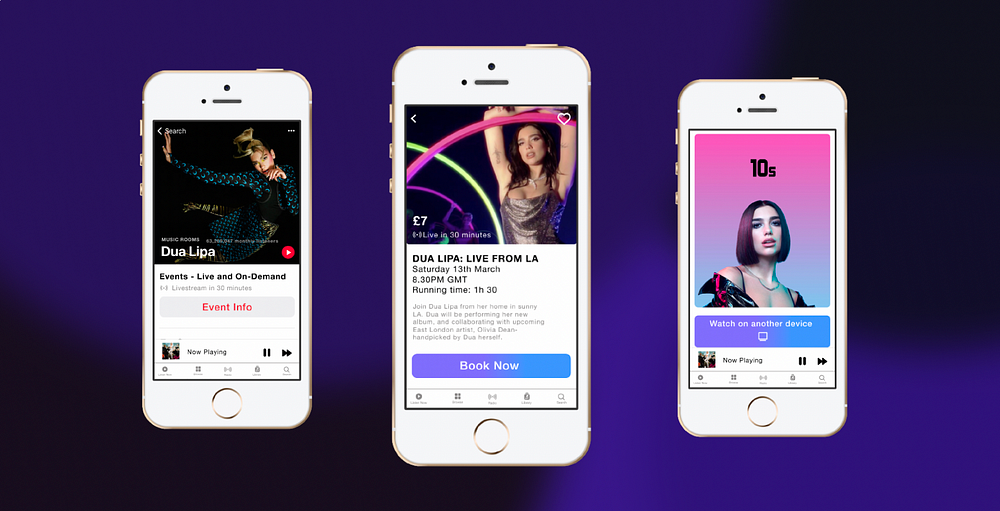Apple Music- Live Show Integration- UX Case Study

Bootcamp: General Assembly
Length of project: 2 weeks
Team: Izzy Silverman, Catherine Allen, Catherine Gates, Charlie Bullman
My role: researcher, UX/UI designer
Overview
My first group project at General Assembly involved me and 3 classmates. We were tasked with an exciting brief- to integrate a new feature- ‘artist rooms’ into the existing Apple Music app- a place for hosting acoustic gigs, podcasts, and chats where artists can interact with their audience. We were presented with a list features that must be included:
- Ability to access a ‘music/artist room’ hub
- Ability to pay for the membership
- Ability to browse and follow artists and get notified when they are live-streaming from their room
- Ability to request to talk or message (both via video and/or via mic) in the music room
- Ability to see the monthly support that the artist gets
- Ability to praise artists with a sort of ‘like/clap’ system
- Ability to save key moments of a ‘music room’ to easily find when event is finished
- Ability to access ‘music room’ history
- Ability to have breakout rooms with other users
- Ability to message the artist privately and ask questions
We had a lot to work with, so we dived straight in to our double diamond process: Discover, Define, Develop, Deliver.
Discover
Competitive/Comparative analysis:
Primarily a music streaming app, Apple Music would be delving into some new territories with the addition of ‘artist rooms’. The livestream requirement with the ability to interact with artists (like/clap/message)brought on a lot of comparative analysis, with the likes of Facebook Live, Instagram Live, and Youtube Live. Our user interviews were to later educate us on how Apple Music’s fan interaction could differ from these other platforms (as I elaborate later). We of course looked into the main competitor, Spotify, and also found a music event booking app called Dice, which was selling livestream tickets from big artists throughout lockdown. We also found Zoom to be a comparative app, in regards to our feature request to allow users to ‘have breakout rooms with other users,’ as well as its ability to host events. With this mixture of competitive and comparative apps, we produced a feature inventory addressing the features that were requested in the brief:

We then looked further afield and became interested in Twitch, a platform built on livestreams. We found the request of ‘see the monthly support that the artists gets’ slightly odd, and possibly distasteful (in the middle of a pandemic!) considering how huge the artists on Apple Music are. This assumption was to be addressed later in our user research, but Twitch gave us some idea of how the monetary aspect could work, with a ‘tip jar’ feature.
We also became excited by the idea of virtual festivals and the use of virtual reality experiences, when looking into the Burning Man Project. Of course, this would be a little wacky and perhaps not so relevant to this project, but we felt inspired by the possibilities that could arise in the future of events- even if they were not to be implemented in this project- so we included this in our comparative analysis:

User Interviews:
We gathered a group of music enthusiasts who have experience with other music streaming and booking apps to find out about how they might want to use our new features. Whilst many were excited by this new element of Apple Music, something they questioned was the ‘ability to pay for a membership’. If they are paying already for a music streaming app, why must they pay a secondary membership on top? This was something to address in our development phase.
Another point of contention was something our group was already unsure of- ‘the ability to see the monthly support the artist gets’. Sure enough, our interviewees had the same thoughts- that they have no desire to see how much money a huge artist is making- something they may expect to see in the news, but not on a music streaming app. This was also taken forward into our development. Many interviewees also noted that there are already numerous apps providing livestreams (Instagram being popular for finding out about artist’s personal lives)- so Apple ‘Music rooms’ would need to be providing something different from them. An expectation from all interviewees is that Apple Music should provide quality ‘behind the scenes’ footage, and the ability to ask artists about their creative process, or something music related- as opposed to frivolous personal questions that they may already ask on an Instagram livestream. They did not expect, or particularly want, to see information related to artists’ personal lives in the ‘Music Rooms’ feature- this reiterated the point about not showing users information on the ‘monthly support.’
Another point on the brief that was questioned was the ‘ability to have breakout rooms with other users’. None of our interviewees saw the value in this- they felt it would be strange to be put in a room with users they don’t know- however, noted they don’t mind seeing messages pop up from other users when watching an Instagram livestream. It therefore made sense to not develop this breakout room feature, and to keep a more limited access to other users, as already prevails in other streaming apps. The ability to ‘clap’, ‘like’, and send a message if desired, is enough for our users, and so we were to take this forward.
Upon asking interviewees how they would feel about the ‘ability to message the artist privately and ask questions’- this excited them. However, they noted that ‘if my favourite artist is Dua Lipa, what is the likelihood she will get back to me!’ A fair point, my group thought about ways we could somehow allow fans to genuinely interact with artists- this would undoubtedly make the app stand out amongst others. There is of course, no way to allow every Dua Lipa fan to interact with her personally- but we came up with an ‘Afterparty’ idea, that I explain later in this study.
Define
From interviewing music enthusiasts, it was clear that the pandemic had an effect on how they would normally attend gigs, and how they have a general feeling of isolation, specifically lacking the ‘buzz’ you may get in the aftermath of going to a gig. We focused on this when creating the user journey map, along with our persona, Martin, who we continuously thought about during our development process.


Upon making our journey map, we then produced our problem statement:
Martin needs a better way to interact and engage with his favourite music artists, whilst accessing live and on-demand content, because his restricted ability to attend real life music events during lockdown has made him feel disconnected.
Develop
Going into our development, we knew from our research which features we needed, and which to discard. We agreed upon these points:
- Change the extra membership to a pay-per-event business model.
- Provide high quality behind-the-scenes content.
- Incorporate an ‘afterparty’ feature, to keep that post-gig buzz going.
- The interface on the livestream must allow interaction from fans- somewhere between TikTok, Instagram, and Twitch.
- Don’t include the ability for fans to see the ‘monthly support’ all artists receive- though, we could find a more tasteful way to do this, perhaps for ‘up and coming’ artists.
As my first group project, this was the first time I had the opportunity to collaborate with ideas via a design studio. It was a great exercise to explore each others’ brains, and a really useful task for us to explain our ideas- even just to see how different our sketching styles are!

Through explaining each of our sketches and conducting some dot voting, we came to an agreement on what the best solutions would be- a piece of everyone’s sketches was truly incorporated, and in hindsight I realise this went very smoothly for a first group project! On we went to make our paper prototype:

We had 6 users to test on throughout our development. We had a number of iterations made on the journey from our sketches to the final prototype. Though mostly small changes, we did have some important ones, notably, the ‘Waiting Room’ and ‘Afterparty’ screens.

During our mid-fidelity development, we decided we could use this ‘up and coming’ artists idea as a supporting artist for more well-known musicians, as a way to get the pre-gig ‘buzz’ going. A small visual change occurred (see above) as we realised just one supporting would be more likely than having multiple- this incidentally made the visuals look cleaner, too. We also added information on the pre-concert ‘quiz’ that fans can do as they wait, about how long it will take, to prevent users feeling they may be trapped and miss the beginning of the concert if they play a game. Additionally, we learned that users were uninterested in seeing the other attendees- though they wouldn’t mind seeing other users reacting in the livestream, they don’t care to see who is going in the Waiting Room, so this was taken out.
The ‘Afterparty’:
The user tests also helped us to decide what content could actually go in the Afterparty, such as merchandise, and show highlights that users can save to watch again later. Our idea of this fictional Afterparty was that it could be a place where the artist is interviewed post-show, and some lucky fans would have their questions picked through a Twitter thread they can access pre-show, which we named #asktheartist. Some users pointed out that having BTS content pre-show could ruin the show itself, and would make more sense to view after, so we took this out of the Waiting Room, and kept it on just the Afterparty instead. Though you cannot replace the atmosphere of a live gig, we hope this afterparty feature could be a way for fans to feel more of a connection to their favourite artists in the virtual space. The prototype can be viewed below:
Key learnings:
- I gained much more appreciation of user research from this project. Since quite a few requirements on the brief did not in fact align with what users want or need, it was a great lesson in learning that more features do not always mean a better experience.
- As my first time working with an established design system, this stressed the importance of having a robust one that you can always refer back to, especially for an expanding product.
- Importance of personas- aside from the more obvious importance of them (that is, to remind us who we are designing for)- I found that our persona was almost like a mascot. Whenever we hit a wall of creativity or tiredness, we would always go back to our beloved Martin, even making jokes about him throughout our project. He was great for our group morale and kept us feeling inspired.
Next steps:
- Develop the Afterparty and #asktheartist feature.
- Develop a path for being notified about livestreams.
- Potential for virtual festivals- consider how you could go in and out of different ‘rooms.’
- What could be changed- the problem statement. This was made during a pandemic where people were feeling particularly isolated, thereby possibly influencing how they use technology. Though the solutions may end up the same, it could be worth having a broader problem statement that is not so focussed on the isolation felt due to the pandemic. If our research was not conducted post-pandemic, we may have had different findings.
I hope you enjoyed this read. If you’d like to chat about any of my designs- or anything else- feel free to contact me on LinkedIn.
